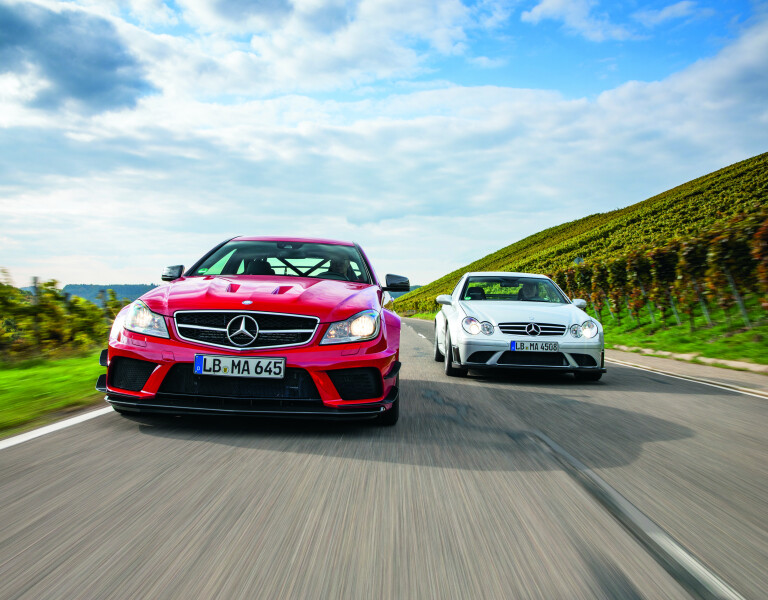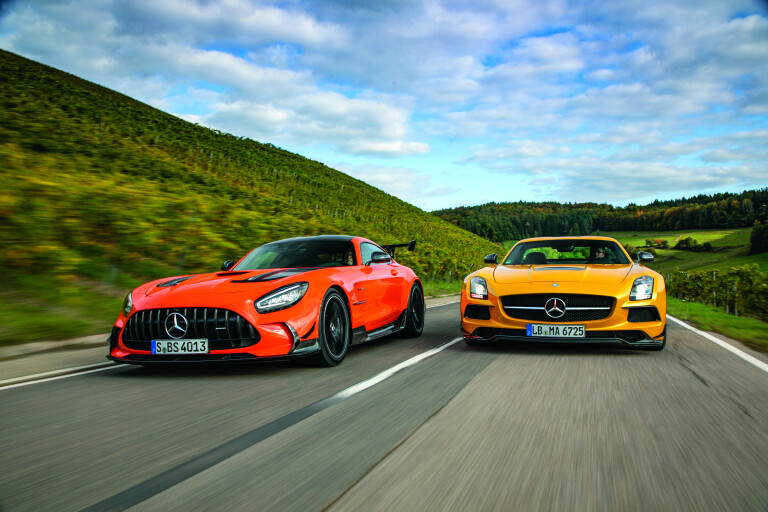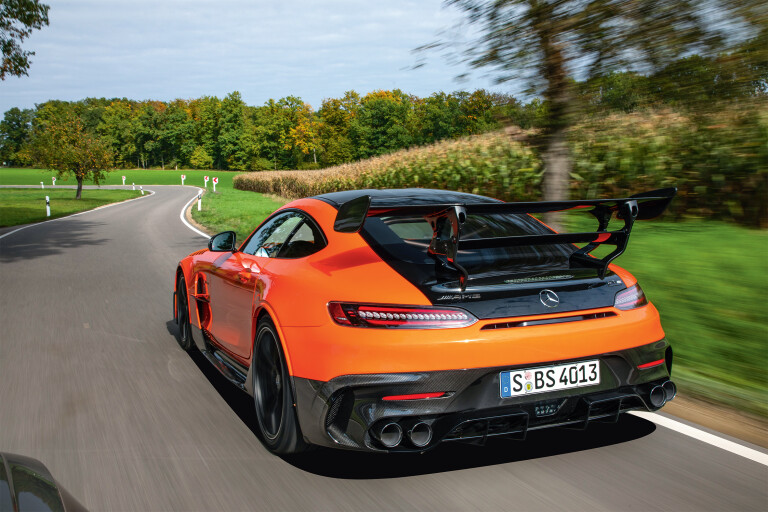
The AMG Performance Studio in Affalterbach didn’t leave us expecting very much. A studio is where you go to get a demi-wave or a manicure. It signally lacks the race-honed grittiness of a garage, a workshop or better still, a skunk works. AMG didn’t help themselves either, their initial press material crowing about how the studio could sell piano black plastic dash fillets for your S-Class. It’s hardly the stuff of legend.
And then in 2006, with little to no fanfare, the Mercedes-Benz SLK 55 Black Series appeared. The SLK 55 AMG’s 5.4-litre atmo V8 had been tweaked from 268 to 294kW thanks to a new inlet manifold, tweaked valve timing and a racier exhaust, the seven-speed automatic box was sharpened for more brutal upshifts, the suspension was beefed up for better body control, and huge brakes lurked behind each of the 19-inch P-Zero Corsa-shod alloy wheels. The sprint to 200km/h dropped from the 55’s 17.5 second figure to just 15.5 seconds. That still stands up pretty well today.
That alone would probably have been enough to pique our attention, but AMG had gone a lot further. It had contracted Austrian ski manufacturer Fischer to replace the heavy folding hard top roof mechanism with a lightweight carbon fixed shell and decked the cabin out in carbon fibre and hard-shell Recaro buckets. It was a true little monster and drove a lot better than the SLK’s slightly fey reputation would suggest, with a hammering 520Nm – although the nose-heavy weight distribution was a killer for front wishbones and bushes.

Despite all the carbon parts, the Black Series still weighed 1495kg, just 45 kegs less than the standard 55, which is a fair whack for a car that measures just 4089mm stem-to-stern, or about the same as a Fiesta ST. Its pricing was also well into Porsche 911 territory. It’s perhaps unsurprising that only 120 found buyers, and prices today reflect that fact, with decent cars changing hands for 150K in Europe.
As good as the 5.4-litre M113 V8 was, it was rapidly eclipsed by an engine that motored straight into the hall of fame; AMG’s legendary 6.2-litre M156. Shoehorning this beneath the bonnet of the CLK 63 Black Series, the first of the Black line that was officially sold into Australia, might have created a legend. A sliver of the 700-unit production run made their way to these shores in 2007, shouldering a $299,000 price tag.
The CLK Black’s problem was that despite the atmo M156 being tweaked from 354 to 373kW, it followed on the heels of the supercharged 428kW CLK DTM AMG (2004-2006), so the Black had something of a wash of penultimate about it. You see, back then, Mercedes had a line above Black, which was dubbed Signature Series, of which the DTM was but one. That’s perhaps why these early Black models are viewed by the market as slightly quirky things. Their message and positioning were never crystal clear. Was the CLK Black a 911 GT3 rival? If so, why pair carbon-composite brakes and F1 safety car styling with a seven-speed automatic transmission?

Straight-line pace is hard to fault. I strapped timing gear to the CLK Black and recorded a 4.1 second 0-100km/h time, which was pretty much bang on top of a contemporary 997 GT3 and better than the 4.3 second official timing. While I didn’t get the chance to explore the 300km/h top-end capability of the CLK Black, the rest of the package was well engineered with revised axles, expensive coilovers, sharper steering, 19-inch forged wheels, and a somewhat stripped cabin.
There was nothing second fiddle about what came next. In 2008 AMG didn’t just up the ante, it changed the rules of the game. With the SL 65 AMG Black Series, Affalterbach certainly went large. At a time when the flagship Lamborghini Murcielago LP670-4 SV could hick up 660Nm before it turned itself inside out, the SL rolled out an easy 1000Nm of 6.0-litre V12 twin-turbocharged grunt. Until the current AMG GT Black Series, this was the only turbocharged Black model. The SL Black was more than the brawn, the 493kW or the 3.8 second sprint to 100km/h. Above all, it was about how thoroughly AMG set about deconstructing Benz’s boulevardier, before transforming it into something malevolent. Here at last was a car that lived the Black badge.
A massive 250kg was shorn from the standard SL 65 AMG, with a fixed carbon-fibre roof, along with composites for the bonnet, boot lid, front wings and rear apron. More than anything it was the SL Black’s stance that set it apart. The front and rear tracks were punched out and shrouded in angular wheelarch flares, the bodywork was liberally hole-punched to massage air in and out before finally macerating it with a rear-mounted fixed aerofoil.

It took four full years for AMG to try to come back from that level of overkill. The SL had changed the public perception of what a Black Series product represented, and expectation was through the roof for the 2012 C63 AMG Coupe Black. Packing 380kW and 620Nm and priced at $245,000, it was no shrinking violet.
The 6.2-litre powerplant borrowed a lot of tech from the SLS project, including forged rods and pistons, a lighter crankshaft and a smarter ECU. The transmission also came in for some love, with a beefier version of the seven-speed auto with AMG’s clutch pack appended to it.
Surprisingly, after the SL, carbon brakes weren’t fitted as standard, and it tipped the scales at 1635kg, even after the rear seats had been ejected. It looked brutal though, with a delightful blending of the C-Class coupe’s slightly voluptuous roofline with a pugnacious stance that had a DTM look, the front tracks widening by 56mm and the rears by a massive 84mm. Six-click coilovers offered track-day fiends something to fiddle with before the almost inevitable return to factory settings.

If you were serious about taking this fairly heavy but hugely entertaining car on track on a semi-regular basis, you’d doubtless tick the box for the optional Track Package which featured more focused Dunlop tyres, active cooling of the rear diff, as well as the AMG Aerodynamics Package with flics, front splitter and adjustable carbon rear aerofoil. In this configuration you could try to replicate the wholly serious 7m43s Nurburgring lap time. Only 650 were slated for production, but the build run was so oversubscribed that AMG eventually loosed 800 cars from the Affalterbach gates.
They were also the last of the ‘sedan platform’ Black models. When the AMG GT models appeared in the line up, Moers openly admitted that this spelled the end of C-Class based Black models. “Black Series is dedicated to two doors cars,” said Tobias Moers. “And you know with GT lineup, there’s no sense of a C-Class Coupe Black Series.” No sense of an SUV either. When that was put to him, Moers was adamant that this wasn’t even in the starting blocks. “No, no, no, no... never. Black Series is for the race track,” he laughed.
The template for the future, and indeed the intensity went up another notch with the SLS AMG Black Series, launched in 2013. Taking its cue from the Customer Sport SLS AMG GT3 car, this never quite managed to eclipse the old SL Black’s power output, falling a few kilowatts short at 464kW. It was nevertheless quicker than the old stager, its 44kW advantage over the stock SLS AMG seeing it to 100km/h in 3.6 seconds. Control was vastly improved, too, thanks to the AMG Ride Control suspension, the ceramic compound brakes, an electronically controlled locking differential, and an optional aero pack.

Few corners were cut in the SLS Black’s development. Weight was slashed by 70kg compared to the standard SLS, with a titanium exhaust and a petite lithium-ion battery featuring. The atmo M159 engine featured a redline increased to 8000rpm and received a completely revised high-speed valvetrain, that included modified camshafts, and new bucket tappets that had a special coating AMG traditionally reserved for its race cars.
The SLS AMG Black was 70kg lighter than the standard SLS, with weight reduction aided by a new titanium exhaust system that cut 13kg compared to the original steel unit. A lithium-ion battery cut a further 8kg of heft. The suspension also came in for a closer look, with AMG engineers making the system 42 per cent stiffer for the Black, while widening the front track 20mm and rear track by 24mm. Only 350 were made.
It was also the final car to feature the 6.2-litre V8. While most of us shed a tear at its passing, we weren’t to know that the 4.0-litre twin-turbo V8 that replaced it would be even better. Miles more torque, better driveability and more tuning potential seemed to fall straight into the lap of the Black philosophy. Except then it didn’t.
When AMG wanted an engine for the AMG GT Black Series, it didn’t just wick up the GT R’s M178 lump. It changed it to a new flat-plane crank design, dubbed the M178 LS2, making it the very first car from Affalterbach to feature such a V8. Different firing order, more boost, higher compression ratio – it all contributes to the Black’s 537W, finally eclipsing the old SL Black as the most powerful AMG model. Only 28 are being officially imported to Australia at $796,000 a pop. Look for it to defend AMG’s crown at next year’s Performance Car of the Year.
With each generation, AMG has refocused the Black ethos as a product line. Where it was once a badge that struggled to define itself, it now clearly stands for extreme road-legal track cars, akin to Porsche’s Rennsport models. For a series of cars defined by internal-combustion engines, it’s clear the future holds certain challenges. AMG’s new era begins right here.




COMMENTS